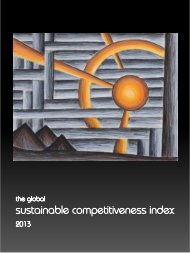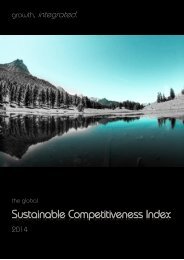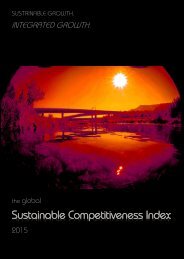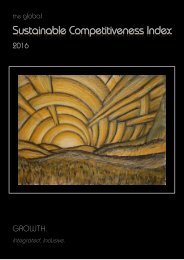Global Competetiveness Report
Create successful ePaper yourself
Turn your PDF publications into a flip-book with our unique Google optimized e-Paper software.
Regional Rankings<br />
Natural Capital<br />
Regional spread<br />
North America, Scandinavia as well as<br />
Australia & New Zealand come out on top of<br />
the regional natural capital ranking – all<br />
regions with comparable low population<br />
density (one of the factors affecting the level<br />
of depletion of the natural capital), coupled<br />
with sufficient availability of renewable<br />
freshwater resources and a rich biodiversity.<br />
South America and Western Africa are<br />
following the top three regions thanks to a<br />
rich biodiversity and favorable climatic<br />
circumstance. The same applies for South-<br />
East Asia. However, higher depletion levels<br />
somewhat lowers the natural capital<br />
sustainability level of this region.<br />
Eastern Africa, Southern Europe, Central Asia<br />
and the Middle East are forming the bottom<br />
of the Natural Capital ranking. Common to all<br />
of these regions is the arid climate,<br />
underlining the fundamental - and until<br />
recently grossly underestimated and<br />
neglected importance of sufficient and<br />
renewable water resources and the stable<br />
supply of clean water for all purposes<br />
(irrigation, human, industrial). Water<br />
availability is also strongly correlated to the<br />
level and richness of the local biodiversity.<br />
North America<br />
Scandinavia<br />
Australia & New Zealand<br />
South America<br />
Western Africa<br />
Eastern Europe<br />
South-east Asia<br />
Southern Africa<br />
North-western Europe<br />
Central America<br />
North-east Asia<br />
Northern Africa<br />
Eastern Africa<br />
Southern Europe<br />
Central Asia<br />
Middle East<br />
0 10 20 30 40 50 60<br />
Average deviation<br />
42% of all countries are above the absolute<br />
World average (i.e. 58% are below average).<br />
The unequal spread between above and<br />
below average indicates that a comparably<br />
small number of countries reach a relative<br />
high score, while the majority of the countries<br />
are somewhere in the middle. Some countries<br />
at the very bottom, affected by the<br />
combination of arid climate, high population<br />
density, and absence of other natural<br />
resources possess very little natural capital<br />
levels even compared to the average.<br />
-75% -50% -25% 0% 25% 50%<br />
Suriname<br />
Cote d'Ivoire<br />
Burma<br />
Bhutan<br />
Egypt<br />
Bosnia and Herzegovina<br />
Malaysia<br />
Portugal<br />
Panama<br />
Djibouti<br />
Mauritania<br />
Mexico<br />
China<br />
Cuba<br />
Israel<br />
Cyprus<br />
The <strong>Global</strong> Sustainable Competitiveness Index<br />
33








